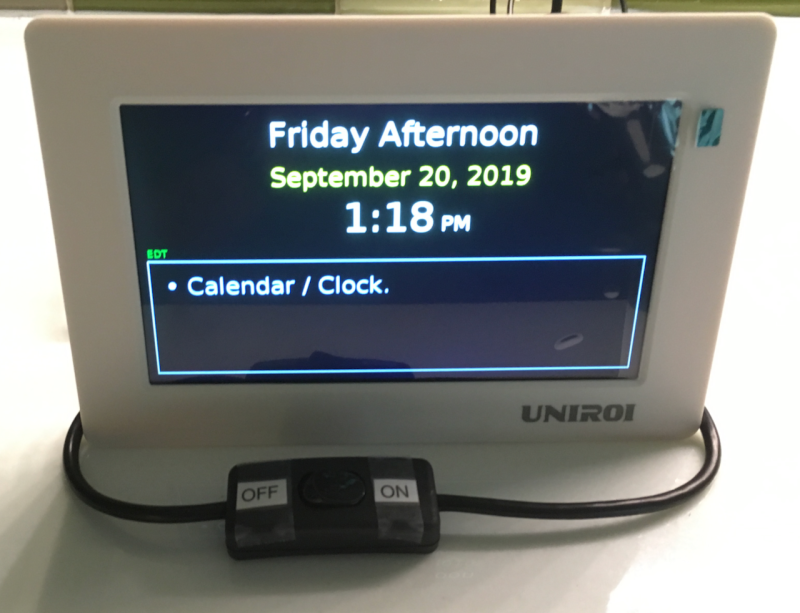A lot of commercial offerings of technology aimed at helping the elderly seem to do a good job on the surface, but anything other than superficial interaction with them tends to be next to impossible for its intended users. Complicated user interfaces and poor design consideration reign in this space. [7402] noticed this and was able to design a better solution for an elderly relative’s digital day planner after a commercial offering he tried couldn’t automatically adjust for Daylight Savings.
Of course, the clock/day planner has a lot going on under the surface that the elderly relative may not be able to use, but the solution to all of that was to make it update over the network. This task [7402] plans to do remotely since the relative does not live anywhere nearby. It is based on a Raspberry Pi connected to a Uniroi screen which automatically dims but can be switched off by means of a large button in the front. The UI shows the date, time, and a number of messages or reminders in large font in order to improve [7402]’s relative’s life.
This is a great idea for anyone with their own elderly relative which might need something like this but won’t want to interact with the technology other than the cursory glance, but the project is also a great illustration of proper design for the intended users. Commercial offerings often had hidden buttons and complicated menus, but this has none of that, much like this well-designed walker for an elderly Swede.
















7402.. I suspect that’s a movie reference, but I can’t remember which one that is. Anybody?
The image on the main page features some PDP-8 opcodes and 7402 is the opcode for HLT. Coincidence? Quad NOR gate doesn’t sound that fun though.
Check out Dementia Diary by Fashmel in the google play store for androids. Any old tablet becomes an instant clock. Same long wording and style. Fonts and config is all exposed.
BUT… It also links to a google calendar. Share the calendar and family can post reminders of birthdays, appointments, sporting events, or simply send a note message.
^this or something similar. If a reasonably modern but no longer en vogue cell phone is available, it could also function as an emergency 911 phone (I believe all cell phones, whether on a plan or not, are always capable of dialing 911). Well this presumes a USA presence and cell coverage.
Thanks for that tip. It looks like a great idea. I’m approaching the age when I might need such a clock. Some of my neighbours already need this. I live in Sheltered Housing (US Assisted Living) so I will show it to our support team.
Even big name companies manage to stuff up user interfaces, particulary software.
One software package (which my company forces me to use) has the user enter data into text fields/boxes. So, the usual thing is to write the code so that pressing enter (or tab) after putting data into the first box takes you straight to the next box… but ohhh no, you have to then move your hand to the mouse to click in the next box for it to take the following data.
Even a high school kid could write better code (probably even a primary school kid).
All thanks to the same company that brought us the PC. Maybe convenience for the end user is not important when all you need to do is impress the beancounters by mentioning your company name.
Anybody know of an answering machine which is designed to be used by elderly or handicapped?
Specifically – one that allows you to set it to more than 4 or so rings before it answers.
Somebody who has to pick up their crutches, get up, slowly walk to the phone
needs more time than 4 rings.
(Cell phone or cordless phone is out because:
They have a pacemaker – don’t want them to have to try to remember to keep the radio phone away from there.
They also have hearing problems – so need the best sound quality (i.e. a corded land line phone).
Also want land line to make 911 service more reliable (cell 911 doesn’t always route to the right
emergency responders, and less reliable for location).
So why can’t we get an answering machine that gives people more time to answer?
Wouldn’t a cordless phone work? The RF energy should be insignificant. If a call is missed, any handset can play back.
OR get a different answering machine with configurable ring count.
OR change to VOIP where their hosted voice mail can have ring count configured. Many support 911 location delivery (like Via Talk) and are significantly less expensive if internet is available.